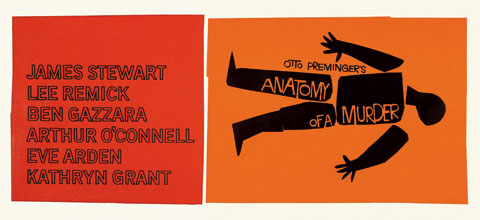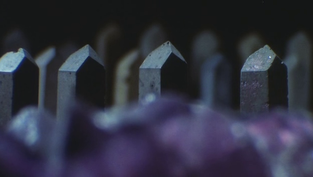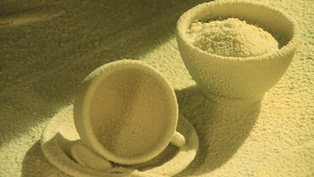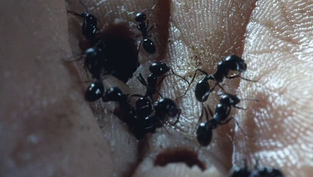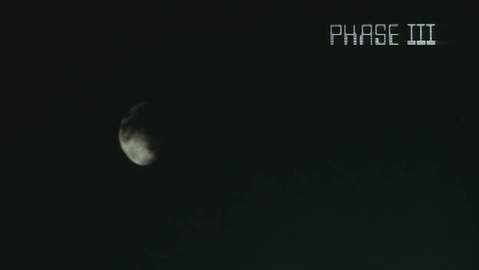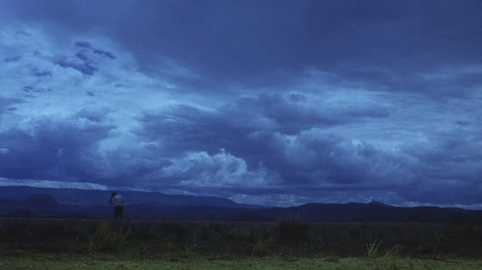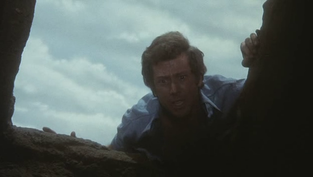Phase IV (1974)
- nickkarner
- Oct 17, 2022
- 9 min read

For master designers Elaine and Saul Bass, the title sequence represented an opportunity to make a bold, imaginative statement in a limited amount of time. Some films don’t require an innovative credit sequence, but can you imagine if every film opened with a simple crawl or individual title cards? The ‘skip intro’ button on Netflix was practically invented to avoid that level of boredom. I adore the slick nature of a Bass-produced sequence. My personal favorite has always been for Otto Preminger’s Anatomy of a Murder (1959), where a man’s cartoon body is disassembled and reassembled at a rapid and frenetic pace. They’d hit a slow patch in the 70’s as the razzmatazz of their early work clashed with the harsh realism a new wave of filmmakers were trying to inject into modern film. They’d come roaring back in the late 1980’s thanks to Martin Scorsese and James L. Brooks, bringing an astonishing career full circle.
The duo’s creativity level is jaw-dropping in their ability to be both simplistic and breathtakingly complex. With all this know-how, it’s logical that Saul Bass, the one most often receiving the credit despite it being very much a dual effort, would take a stab at directing a feature of his own. After all, he’d already worked with some of the greatest directors who ever lived, including the aforementioned Preminger, Martin Ritt, John Frankenheimer, Robert Wise, and of course, most famously, Alfred Hitchcock. Plus, he’d already won an Oscar for his short documentary, Why Man Creates (1968). Few of the directors, including Hitchcock and Preminger, had ever received that honor. It may seem a tad odd that his choice of film debut would be, in the most generic of terms, a Man vs. Nature film, a very popular subgenre from the 1970’s. The devil is in the details, however, and I believe that is what drew him to make the thought-provoking and haunting Phase IV (1974).

As was the case in Maximum Overdrive (1986), but with far less cocaine, strange phenomena in space have a subtle but devastatingly powerful effect on seemingly harmless beings. As our narrator informs us, “effects went almost unnoticed because it happened to such a small and insignificant form of life.” In this case, ants. All of them. He continues to explain, “Different species of ants. Meeting. Communicating. Making decisions.” Save for the brief narration, we’re treated to a mesmerizing and wordless opening sequence which lasts nearly ten minutes. Forget Wall-E’s famed dialogue-free beginning. Here, a trippy bit in space is followed by the first of many micro-photographed scenes involving the famed ants.
The combined work of Ken Russell’s regular cinematographer Dick Bush, who would also lens Piers Haggard’s The Blood on Satan’s Claw (1971) and William Friedkin’s masterpiece Sorcerer (1977); and Ken Middleham, whose role as a micro cinematographer led The Hellstrom Chronicle (1971) to Oscar glory, is incredible. Accompanied by a score and soundscape of eerie power by Brian Gascoigne, the ants are photographed toiling away in shadowy tunnels, clearly up to something. All of this is identified as Phase I. We discover that their natural predators, “mantises, beetles, millipedes, and spiders” are being eliminated by large swarms of ants which converge from all sides. What sets these scenes apart from simple nature photography we’ve seen a million times before is the narrative function of the ants’ actions.

A scientist, Dr. Ernest Hubbs (Nigel Davenport, the great British actor of A Man For All Seasons, The Island of Dr. Moreau, Nighthawks, Greystoke, and Chariots of Fire) arrives in Paradise City (TAKE ME DOWN!) to study and investigate the “immediate full-scale attack on the threat of biological imbalance to other life forms.” He brings along an assistant, James Lesko (Michael Murphy, one of Robert Altman’s favorite actors) to see if he can discover the “language of the ants.” A dome-shaped station is built that looks like the top of the Epcot Center and it’s filled to the brim with awesomely retro (and very big) computer equipment. It sits near tall structures which house the ants, who remain silent for weeks. We get a bit of ‘ant-vision’ as they eye their next targets.
Paradise City is desolate, with most of the few inhabitants having already evacuated. A horse farmer, Mr. Eldridge (Alan Gifford, Town without Pity) is setting up a gasoline-filled trap for the ants. His wife Mildred (Helen Horton, voice of Mother in Alien), his ranch hand Clete (Robert Henderson, two Superman films), and his lovely granddaughter Kendra (Lynne Frederick - Nicholas and Alexandra, Vampire Circus) must evacuate. These are the only other humans we will meet in the entire film. With nearly all action confined to the station and the various underground dwellings of the ants, the film is practically a science-fiction chamber piece.
Phase II has begun, wherein the film appears to signal that the humans are the ones initiating the phases, but we’ll soon find out that’s not the case. Tired of waiting and pressured by the folks footing the bill, Hubbs uses a grenade launcher to blast the ominous structures and Lesko hears their protestations over his speaker system. “Hi there,” he says.
Later that night, one of Mr. Eldridge’s horses is attacked by thousands of ants. They light the fire but their house starts falling apart because of the ants’ concentrated destruction. Escaping in a truck, they race toward the station, but ants are in Eldridge’s hair, causing him to crash. Meanwhile, the ants have also sabotaged the truck holding the generator for the station, which explodes. Dr. Hubbs give them a big ‘fuck you’ and blasts them with “100% yellow,” a massive amount of chemicals which not only kills the ants, but also the Eldridges who get caught in the deadly “rain storm.” The dying ant footage is juxtaposed with Mr. and Mrs. Eldridge struggling to survive. We’re not so different, you and I.
Hubbs and Lesko emerge, dressed in silver suits. The yellow covers everything and they look as though they’re on the moon. The dead bodies hold very little interest for Hubbs, who continues to be amazed by the ants ingenuity and hive mind capacity. Hubbs comments, “So defenseless in the individual. So powerful in the mass.” Earlier, they’d come upon a dead sheep with a few holes in its side. Seeing Clete with his fist clenched, Hubbs cracks it open with a rod, revealing two holes in his palm, out of which several surviving ants emerge. He sucks them up for experimentation. Kendra steps out from a nearby cellar and they take her inside. Lesko has a soft spot and wants her rescued right away, but Hubbs ignores all this and focuses on his work.
As they prepare to subject the captured ants to various experiments, Kendra wanders in and there’s a cool rear projection shot of an ant staring at a giant Kendra. She loses it and starts to smash the ants and the equipment. Goddamnit Kendra! She’s hustled out and Hubbs is bitten on the arm. They believe the yellow poison should keep the ants away for three to four days, but they’ve once again underestimated them.
An ant grabs a chunk of yellow and drags it through the tunnel. It dies from the exposure and as it dies, another ant comes to take it’s place. It’s riveting stuff as they each die to get it a little farther. We get to a large ant, presumably the queen, with a large sac, very reminiscent of the alien queen in Aliens (1986). She gobbles down the poison and gives birth to new ants, which have a resistance to the yellow substance.
While Lesko shows Hubbs a visualization of the ant language, reflective structures have been built, causing the sun to shine light onto the station and drive the temperature higher and higher in an attempt to “fry them.” Lesko laments, “I did not sign up for war with a bunch of goddamn ants!” He tries to contact the outside world for help but damn if the ants haven’t also disabled their communication system. We discover humans can survive in temperatures around 120 degrees, but their computers automatically shut down at 90 degrees. In a mind-blowing sequence, a single ant diligently chews on the wires inside the air conditioning unit. A praying mantis hovers above and snatches it up. A weird pale ant with a bright green abdomen snags the mantis by the leg, causing it to fall on a part of the unit’s innards and fry the circuits.
Hubbs’ arm swells and he begins to lose his mind while Lesko uses sound frequencies to destroy the reflectors. The constant tug-of-war between ants and humans keeps the story moving at a brisk and exciting pace. The main characters are likable enough that you really do get anxious as the ants keep dismantling the equipment and laying waste to their plans.
The devastation of the reflectors doesn’t go unnoticed. There are scores of dead ants, each laid out in concentric rows, as if for a funeral. Thanks to Middleham’s excellent work, the close-ups on the ants actually make them look somber and vengeful. Who’d have thought ants could act?
Lesko sends the ants a coded message, believing that “mathematics is the universal language of intelligent creatures.” Hubbs’ mental state grows worse and the ants appear to be hurting his pride. He used to walk around shouting, “Who’s got the biggest brain?” As John Heard said in My Fellow Americans (1996), “Who’s the idiot now?"

Phase III has begun as Lesko receives a response to his message and Hubbs realizes he has to destroy the queen. The message is baffling, but Lesko hypothesizes that they “want someone.” Perhaps, “they are the experiment.” Kendra leaves the station, singing “Leanin’ on the Everlasting Arm,” the song immortalized by Robert Mitchum in The Night of the Hunter (1955), and the last we see is her foot covered in ants.
Hubbs believes he’s located the queen in a mound of dirt. He stumbles out but falls into a deep trap devised by the ants. Although it’s not completely shown, he’s consumed by millions of the creepy crawlies. Lesko puts on his suit and starts spraying blue chemicals. The film’s editing begins to mirror his mental state and exhaustion. His face mask gets cracked (damn, did they not have plastic masks back then?); he removes it and slides down a hole in the mound and into a pit of sand. Kendra rises up and they embrace. He realizes, “they wanted…us.” Several superimposed images and wild effects indicate a world in which they are together but not of their own free will. Lesko concludes the film with a voiceover: “We knew then, that we were being changed…and made part of their world. We didn’t know for what purpose…but we knew, we would be told.” A red sun rises over the mountains and the intense and creepy score ceases. We’re left with nothing but background noise as very basic credits roll. The title, which we have never seen, fades in. The fourth phase was total world domination.
Now, let’s be clear. This was the theatrical release ending distributed by Paramount. As is often the case, a filmmaker’s work was tampered with and the footage was believed to be lost. For YEARS, the only way to see any semblance of the legendarily insane original ending was to watch the trailer carefully since bits and pieces were scattered throughout. Then, in 2012, an early cut of the film was discovered and as of 2020, the ending was made available for download and on Blu-Ray. To call the original conclusion hallucinogenic would be an understatement. I absolutely don’t agree with Paramount’s decision to cut this scene down, but I’m assuming it was just too much for the studio brass to handle. The ants still win in both cuts, it’s just that the ‘lost ending’ shows us a series of unsettling and mystifying images of what the world would become under the dominion of the ants. Some images I couldn’t even decipher; others, like Lesko and Kendra running through a maze, faceless people, burning fingers, ants lording over collections of people as if in a butterfly collection, tons of double exposure, are beyond belief. The most shocking moment of all involves a pair of fingers breaking through a person’s forehead from inside their skull and ants come crawling out. There’s also an indication of an everlasting sexual ecstasy to being colonized by the ants. It’s as if Bass made an art film disguised as sci-fi bug flick.
Man vs. Nature films were huge in the 70s and there were plenty of variations on the theme. The same year as Phase IV, Killer Bees (1974) was released. Later, we’d get the awful The Swarm (1978), Arachnophobia (1990) way later, the uncompromising Kingdom of the Spiders (1977), the TV movie Ants! (1977), and of course, Empire of the Ants (1977), an absolutely hilarious movie filled with miserable pricks and pheromone-induced ant worship. Maybe it’s because of the craftsmanship or perhaps it’s just that it takes itself very seriously, but I think Phase IV is the best of the 70’s killer bug movies. In fact, I believe it’s a masterpiece. I don’t think there’s a false move in the film. Yes, in it’s own way, it’s imperfect and definitely off-putting. It could even be slow to some, but I think it’s brilliant. Credit underrated sci-fi screenwriter Mayo Simon for a tight and unpredictable screenplay which never lets its protagonists off the hook.

It’s very unfortunate that Bass’ experience on Phase IV would sour him on future feature film projects. Who knows what he might have accomplished? I wonder whether his next film would have been small in scale in terms of actors, since he was used to working with his wife and few others for their famed title sequences. Perhaps it would have been a natural progression that his next movie would’ve featured double the actors, multiplying for each film, until he’d graduate to directing epic films with as many as 20(!) actors! Who knows? Phase IV represents a high watermark for intelligent science fiction storytelling.









